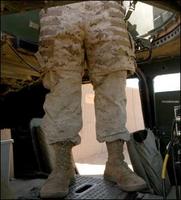 As I was reading an article from Euphoric Reality called Saving Ryan's Privates regarding new armored shorts, I was struck by their similarity to medieval armor from Europe and even Japan.
As I was reading an article from Euphoric Reality called Saving Ryan's Privates regarding new armored shorts, I was struck by their similarity to medieval armor from Europe and even Japan.  As can be seen in this image of a knight circa 1066 and the Battle of Hastings, warriors had long determined the necessity of adding protection to their upper legs and groin area. This knight is wearing a one piece chain mail hauberk that includes leg areas that are not simply a product of a split skirt on a long shirt, but actually complete enclosed legs.
As can be seen in this image of a knight circa 1066 and the Battle of Hastings, warriors had long determined the necessity of adding protection to their upper legs and groin area. This knight is wearing a one piece chain mail hauberk that includes leg areas that are not simply a product of a split skirt on a long shirt, but actually complete enclosed legs.Several other thoughts percolated as I looked at images of armor, both modern and ancient:
War, however technologically advanced materials or weapons, still depends on man to wage it. Regardless of advances, in order to win a war, there are only two options, completely destroy the enemy population (as in exterminate; nuclear) or occupy territory with men. Since even modern war requires this manpower, it is imperative that the aggressive parties retain a ready supply of men along with munitions. Since a dead man can be of no further assistance and it takes somewhere between 15 and 18 years to develop a human being that can actually serve strategic purposes (as opposed to just being cannon fodder which still needs to be replaced and cannot occupy land), it is even more imperative that the individual soldier be protected as a priceless commodity, particularly since his war experience provides the basis for future successful tactics. To this end, man has forever been attempting to create individual protection, more recently referred to as armor, since man figured out how to skin an animal and tan it's hide. With each successful attempt at reducing harm to the individual warrior, the opposing force has always spent an equal amount of time figuring out how to defeat that protection.
Second, the vulnerable areas of the body have never changed even if medicine has advanced enough to repair certain injuries, other traumatic injuries to the same areas are still deadly.
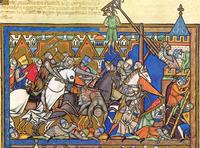
Third, the type of wounds that can be suffered do not change. They can be broadly classified into three types: blunt force trauma, penetrating wounds and amputation of limbs.

Fourth, with every evolution of armor, weapons and tactics, the armorers responsible for creating personal protection for warriors continuously "re-invent the wheel".
Roman circa 182 BC

 Rome circa 200 AD
Rome circa 200 AD ...............................Saxon-Norman circa 1066
...............................Saxon-Norman circa 1066
Circa 15th century
 Italian circa 16th century
Italian circa 16th century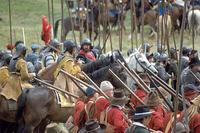
..........Cromwell's Cavalry circa 1644
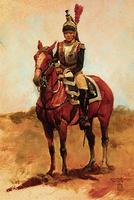
French Cuirassier Napoleonic Wars
 WWI Soldier w/simple chest plate and helmet
WWI Soldier w/simple chest plate and helmet
Personal Body Armor Vietnam also referred to as a "flak jacket"
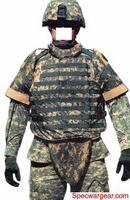 Interceptor Body Armor 2005
Interceptor Body Armor 2005
.........Armored shorts

This man would recognize his modern counterpart.
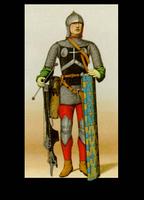 This man would certainly recognize his.
This man would certainly recognize his.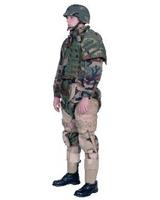
There are problems with "up armoring" men in modern manouver warfare. Mainly, the weight and the configuration can greatly reduce speed and mobility. On the other hand, when your infantry forces now rely on vehicles to speed them to their destination and the most deadly force that they will face is not necessarily a bullet but thousands of pieces of shrapnel, close up and personal, some of which actually may be derived from the vehicle they are riding in, that type of personal mobility maybe secondary to survivability. Even more so, as the enemy adapts and learns how to defeat the armor on mobile units, it becomes even more necessary to protect the individuals. Add to that the cost of casualties, not just in tactical or strategic significance, but political as well, the need for appropriate body armor becomes even greater.
New technologies may be developed to protect or defeat. New materials can be stronger and lighter. However, the wounds and the biophysics of a human remains the same thus the type and places of protection do, too. There is something that can be learned from the evolutionary history of armor even further back to the Greeks and Trojans, much less Roman or Medieval periods. Each evolution had a specific design feature meant to defeat a specific type of weapon advancement or wound whether that be from blunt weapons, sharp heavy swords or projectiles. Based on the apparent slow and painful re-invention of modern body armor, it seems clear that those involved in creating this armor need to go back and learn (if they ever did) these evolutions and reasons.
Or, the DoD or it's contractors need to hire a few historians, metallurgists and modern day metal armor makers to go along with their biophysics and engineering majors so they can learn this lesson a little faster. It's all good and well that we develop new materials to strengthen and lighten the armor, as the good armorers of the 13th and 14th centuries found when they were able to create steel plate armor beaten to within a 1/4th of an inch yet still able to perform it's primary duty. but, aside from articulation, the engineering and design of the armor itself provided additional protection.
In part II of "re-inventing the wheel", we will review the evolution in the specific design of both the armor and the weapon it was meant to defeat and how it might apply to modern body armor.
Thank you Mudville Gazette for the link.




















8 comments:
Nice Research. Lets hope the politics of sex doesn't get in the way of its deployment. 8 extra pounds might be an inconvenience for a man but for many women its job interfering. The Army loves uniformity, and if they adopt these shorts then EVERYONE will be expected to wear them. 30 or so years ago the Army went from the superior M-14 rifle to the M-16 for what many to believe to be weight reasons alone (translation, the M-14 was too heavy for women to use). A little later the Army went from the superior .45 caliber pistol to the 9mm. Again.... "weight reasons". We might think no way would we sacrifice soldiers's lives under the altar of PC, but there can be no doubt that US soldiers were killed in Vietnam as they battle tested the oft-jammed up early M-16 models. Think Harrison Bergeron: (http://en.wikipedia.org/wiki/Harrison_Bergeron).... to be "fair" these shorts should only weigh 4 pounds for women. Many people still think of the military as an instrument of civilian social experimentation.
There is a new material that caused an initial stir. I haven't heard anything about it lately, though. The material is flexible, but only at low speeds. You can run in it, bend it, stretch it. But if anything tries to make it move too fast (a bullet, an explosion, etc.), then the material becomes rock hard.
Whether or not they have had any success in producing functional armor with it -- I haven't heard.
Bronson, I disagree with you on the reason why weapons went to "lighter" versions.
first, both the .45 and the M1 or M14 were replaced long before women were accepted as anything other than nurses or clerical staff. Women did not spend much (if any) time getting range time and learning to fire these weapons.
The purpose of changing to lighter weapons had many reasons. The first and main reason was that warfare tactics had changed to what may now be called the super blitz. Mobility and speed became paramount. When you are looking at using helicopters or needing to move quickly and quietly through a jungle terrain, the less weight for the weapon the better because this meant that helicopters could carry more men (there are issues with weight and lift) and men could carry more ammunition, food and now, even body armor. It's all about how weapons interact with tactics, not about PC stuff like women handling the weapons.
There was a secondary issue which revovled around UN agreements on the size and make of bullets. Certain bullets were considered to be "inhumane" (yeah, laugh) because they caused so much damage that people were more likely to die and that they could pass through someone and injure "innocent bystanders". So, there is an agreement on the size of the ammunition. In which case, the M-1 and M14 simply were too costly to re-engineer to except this new ammunition. it gave a perfect excuse to completely do away with these weapons and kill two birds with one stone: modern lighter infantry with a modern lighter bullet.
by the way, the new bullet had some excellent advantages that are slightly offset by it's size and heft. It travels faster, but makes a smaller hole, takes more to effect the enemy. it's cheaper, even in quantity, but requires more to take down the enemy. It travels faster and farther, but can be more effected by wind and other climate issues effecting it's accuracy.
It all comes down to what the military wants to achieve: fast, light, cheap...isn't that how it always is?
So, I have to disagree on the reasoning for the changes.
However, I do believe that the article said these first armored shorts were being tested with turret gunnes in Humvees, APCs and possible tanks since these are the ones that suffer the most wounds to the groin and upper thigh area from ieds due to their exposure in a turret. I believe that, if you look at the last modern armor image that I put up, they are experimenting more with separate armored leggings strapped on for more mobile soldiers (like infantry).
Gadfly, they are experimenting with "liquid armor" which is basically a kevlar or "spectre" based liquid that would be infused with material to provide that stoppage. I understand that they are currently seeing what sort of effect it has on current BDUs. However, I believe that this will be but another helpful "layer" as opposed to turning into the main armor for soldiers since, as they have discovered with even the interceptor armor, the bullet may be stopped, but soldiers are still suffering from "blunt force trauma" due to impact of the bullet. This has led to some innovations I plan to point out in Friday's post.
Frankly, what i believe we will see, future warrior images aside, is a return to light contoured armor.
Think batman's suit without the pointy ears but including that lovely molding that gives the impression of a muscular body (whichever wimpy actor they get to wear it). there's a reason that the greeks, romans and even eventually medieval armorers used contouring and fluting. it wasn't about asthetics either, though they did turn it into a nice art form.
Kat,
Very nice points thank you. There also could be a NATO 5.56 vs 7.62 caliber alignment (all of us using the same size) in the mix as well. Yes the weapons weight theory could be just a conspiracy, but all the gun nuts will tell you that if you want to stop someone you want a 45 over a 9 mm any day. As for the rifle, many Army snipers will still go with the M-14 over the M-16; which is quite frankly, toylike. The M-14 has much in common with the AK-47, which is reknowned for its reliability and ease of use.
However I agree with your other justifications about weight and mobility. Take the HUMMV debate about uparmoring vehicles designed to be light and easily transportable. Plus the M-16s and 9mms are much cheaper, Army likes that too
When the Army (and police force for that matter) spec out what weapons to use, I do think that a requirement that "all persons must be able to be proficient in firing the weapon" would be near the top of the requirements list. Many women (and yes some men.. men who shouldn't be allowed to join) have problems qualifying with a .45 because its too heavy for them. Thus the pressure on the Army and police forces to ditch the heavier personal armament.
I'd agree that there are many reasons to go with inferior weaponry but would argue that as you add women to a fighting force you make it a physically weaker one. Seems naive that this reality would not be considered during weapons and personal armor selection. I do think that there are those out there that will claim requiring more body armor will discriminate against women for the same reason that the Army has different physical fitness and body fat standards for men and women. The enemy doesn't fight women more softly than men. But to avoid the perception of bias the qualifications for entry in the military are different based on sex.
If you start armoring up the troops so much that women are falling out as heat casualties left and right then the cries of discrimation will happen. I just hope we uparmor our troops anyway, PC or no.
Thanks for your well thought out response,
Bronson
Great post Kat. I have shot an m-14, (it's ok), and an M-16 (seemed a touch weak), and several other weapons.
I like the MP5....light, accurate and sweet to shoot. Packs a good punch when used in the .40 configuration.
Great post going to check out part 2.
Riceburner147 many US miltary snipers use the M-14. As far as accuracy you might want to look into the manufacturer of your model.
check out
americansnipers.org
In the photos section you will see pics with plenty of m-14s.
(wouldn't hurt to make a donation while your there)
Sorry for getting off topic.
"Air To Mud"
I have some things to say about the entire caliber debate, but it would be like beating a (very) dead horse so I'll stay out of it. A good article, but one thing I might add is that in terms of wound types I believe they have changed over the years. In ancient times times the traditional blunt force, penetrating and slashing models worked, but for modern warfare one needs to add thermal and blast injuries as well (injuries caused by overpressure from explosions).
Level 4 body armor Pretty good post. I just stumbled upon your blog and wanted to say that I have really enjoyed reading your blog posts. Any way I'll be subscribing to your feed and I hope you post again soon. Big thanks for the useful info.
Post a Comment